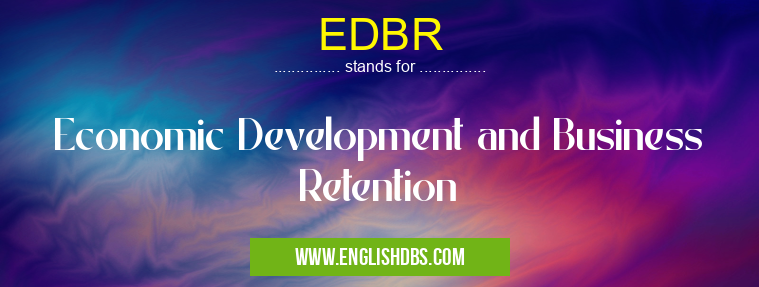What does EDBR mean in
EDBR stands for Economic Development and Business Retention. It is a term commonly used in governmental and economic development contexts to refer to strategies and initiatives aimed at fostering economic growth and preserving existing businesses within a specific geographic area. By implementing EDBR programs, governments and economic development organizations strive to create a favorable business environment, attract new investments, and support the growth of existing enterprises.

EDBR meaning in in Governmental
EDBR mostly used in an acronym in Category Governmental that means Economic Development and Business Retention
Shorthand: EDBR,
Full Form: Economic Development and Business Retention
For more information of "Economic Development and Business Retention", see the section below.
» Governmental »
EDBR Meaning in Governmental
EDBR plays a crucial role in governmental operations as it aligns with broader economic development goals. Local, regional, and national governments often establish EDBR departments or agencies to spearhead initiatives that:
- Promote economic growth: By attracting new businesses, expanding existing ones, and creating jobs.
- Enhance competitiveness: By improving infrastructure, providing incentives, and fostering innovation.
- Support local businesses: By offering technical assistance, training, and access to resources.
Essential Questions and Answers on Economic Development and Business Retention in "GOVERNMENTAL»ECONOMY"
What is Economic Development and Business Retention (EDBR)?
EDBR is a strategic initiative that focuses on promoting economic growth and job creation within a specific region. It involves various activities aimed at attracting new businesses, supporting existing ones, and retaining current jobs.
Why is EDBR important?
EDBR plays a crucial role in strengthening local economies by:
- Creating new jobs and increasing employment opportunities
- Diversifying the economic base and reducing reliance on specific industries
- Improving the quality of life for residents through increased economic activity
- Attracting and retaining skilled workers and businesses
What are the key components of an EDBR strategy?
An effective EDBR strategy typically includes:
- Business attraction: Identifying and targeting businesses that could benefit from locating or expanding in the region
- Business retention: Providing support to existing businesses to help them grow and succeed
- Workforce development: Ensuring the availability of a skilled and educated workforce to meet the needs of businesses
- Infrastructure and amenities: Investing in transportation, utilities, and other infrastructure to attract and retain businesses
What are the benefits of EDBR for businesses?
Businesses that locate in or expand within an EDBR region can benefit from:
- Financial incentives, such as tax breaks or grants
- Access to skilled labor and training programs
- Marketing and promotional support to increase visibility
- A supportive business climate and a network of resources
How can I get involved in EDBR efforts?
There are several ways to participate in EDBR initiatives:
- Join local business organizations or economic development councils
- Attend industry events and networking opportunities
- Contact your local government or economic development agency for information on programs and resources
- Support educational and workforce development initiatives
Final Words: EDBR programs are vital for sustainable economic development and prosperity. By focusing on both business retention and attraction, governments and economic development organizations can create a vibrant and thriving business ecosystem that benefits the local community and economy. EDBR initiatives should be tailored to the specific needs and opportunities of each geographic area, ensuring that they effectively address the challenges and leverage the strengths of the region.
